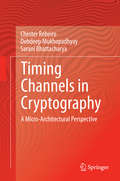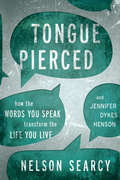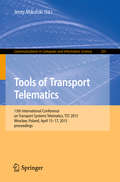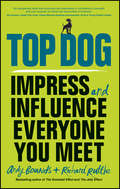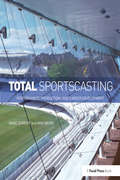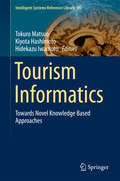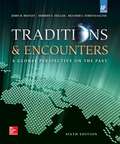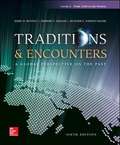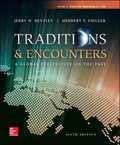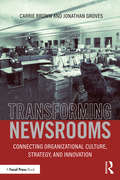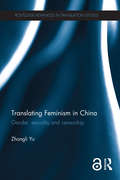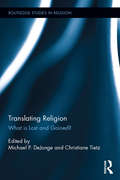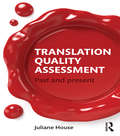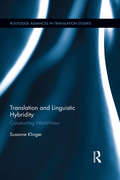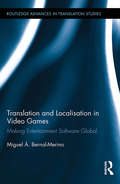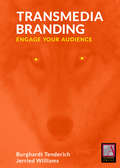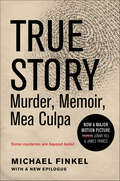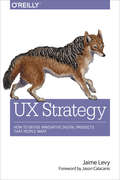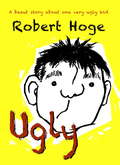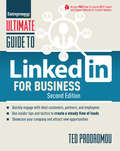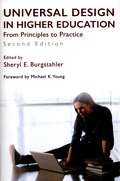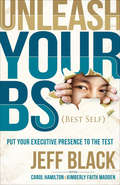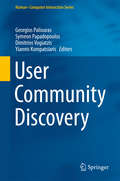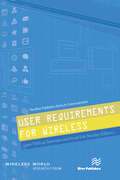- Table View
- List View
Timing Channels in Cryptography
by Chester Rebeiro Debdeep Mukhopadhyay Sarani BhattacharyaThis book deals with timing attacks on cryptographic ciphers. It describes and analyzes various unintended covert timing channels that are formed when ciphers are executed in microprocessors. The book considers modern superscalar microprocessors which are enabled with features such as multi-threaded, pipelined, parallel, speculative, and out-of order execution. Various timing attack algorithms are described and analyzed for both block ciphers as well as public-key ciphers. The interplay between the cipher implementation, the system architecture, and the attack's success is analyzed. Further hardware and software countermeasures are discussed with the aim of illustrating methods to build systems that can protect against these attacks.
Tongue Pierced
by Nelson SearcyWords. They can seem tiny and insignificant, but they have tremendous power. They create our atmosphere, ignite psychological connections, shape our thinking, determine our actions, and ultimately construct our reality. Our words can strengthen relationships or tear people down, lead to success or ruin a lifetime's legacy. Words can truly change our world. It's up to you to determine whether that change will be for better or for worse. The words you allow to flow from your mouth will shape your circumstances. This practical guide will show you how to choose your words wisely in order to create the life you want.Includes the "30-Day No Cursing Challenge."
Tools of Transport Telematics
by Jerzy MikulskiThis book constitutes the proceedings of the 15th International Conference on Transport Systems Telematics, TST 2015, held in Wrocław, Poland, in April 2015. The 35 revised full papers and two short papers included in this volume were carefully reviewed and selected from 115 submissions. The papers provide an overview of solutions being developed in the fields of transport telematics and intelligent transport systems.
Top Dog
by Andy Bounds Richard RuttleGet the results you want and come out as the Top Dog in everyconversationFancy being the 'Top Dog' in all your dealings? Fedup of feeling like the underdog? So many of us regularly'lose' in conversations before we've even openedour mouths? Often without realising it, we don't seeourselves as a peer of the other person. And we transmit this inwhat we do and say ("I'll fit round you. I knowyou're really busy.") The other person picks up onthis. And, without doing a thing, they're suddenly incharge!Top Dog will teach you how to lead in all your interactions, so youcan get more of what you want, more often.Together, Andy Bounds and Richard Ruttle are experts at helpingpeople achieve more from their conversations with others. Theirtechniques work in every type of interaction--conversations,socialising, dating, interviews, sales, marketing, and networking.Basically, anytime you want to impress and persuade others.Top Dog:* Details the skill set needed to gain competitiveadvantage from the outset * Provides instructive and thought-provoking content,relevant to both beginners, and seasoned professionals* Contains insights from working with some of theworld's largest companies* Addresses how to achieve more from interactions inbusiness and social arenas
Total Sportscasting: Performance, Production, and Career Development
by Max Negin Marc ZumoffWhether you want to be in front of the camera, on the microphone, or behind the scenes, Total Sportscasting gives you the skills you'll need to become successful in this dynamic industry. This book covers everything from performance and production techniques to all aspects of sportscasting, good broadcast writing techniques, and how best to forge lasting relationships with team personnel. It also delves into the unique issues facing women sportscasters. And when it comes to breaking into the business, Total Sportscasting devotes entire chapters to career development and demo reel production. For important perspective, we've also included chapters on the history of sportscasting and attempts to glimpse into its future. Total Sportscasting is packed with a variety of features for both learning and instructing: Complete coverage of every aspect of the sportscast, helping you prepare for any platform--TV, radio, and the web Interviews with successful sports journalists, producers, and directors who give you an inside look into the real-world practices of the industry A companion website, which provides additional resources for both instructors and students, including video and audio examples and links to additional resources: www.totalsportscasting.com
Tourism Informatics
by Tokuro Matsuo Kiyota Hashimoto Hidekazu IwamotoThis book introduces new trends of theory and practice of information technologies in tourism. The book does not handle only the fundamental contribution, but also discusses innovative and emerging technologies to promote and develop new generation tourism informatics theory and their applications. Some chapters are concerned with data analysis, web technologies, social media and their case studies. Travel information on the web provided by travelers is very useful for other travelers make their travel plan. A chapter in this book proposes a method for interactive retrieval of information on accommodation facilities to support travelling customers in their travel preparations. Also an adaptive user interface for personalized transportation guidance system is proposed. Another chapter in this book shows a novel support system for the collaborative tourism planning by using the case reports that are collected via Internet. Also, a system for recommending hotels for the users is proposed and evaluated. Other chapters are concerned with recommendation, personalization and other emerging technologies.
Traditions & Encounters: A Global Perspective on the Past (Sixth Edition)
by Jerry H. Bentley Herbert F. Ziegler Heather Streets-SalterConnect students to the stories of history. Connect students to the experience of history. Connect students to success in history. At McGraw-Hill, we have dedicated the past few years to deepening our understanding of student and instructor experience. Employing a wide array of research tools including surveys, focus groups, and ethnographic studies, we've identified areas in need of improvement to provide an opportunity for greater learning and teaching experiences. The fifth edition of Traditions & Encounters is a result of this. Traditions & Encounters also has a rich history of firsts: the first world history text to take a truly global perspective on the past; the first to emphasize connections among cultures; the first to combine twin themes with a seven-part framework, making the huge story of world history more manageable to both teach and learn. Now Traditions & Encounters becomes the first truly interactive world history program: one that marries groundbreaking adaptive diagnostics and interactivities with a captivating narrative and engaging visuals, creating a unique learning environment that propels greater student success and better course results. Instructors gain insight into students' engagement and understanding as students develop a base of knowledge and construct critical thinking skills. Chapter-opening vignettes and a lively narrative keep students turning the page while the adaptive questioning for each chapter and the personalized study plan for each individual student help students prepare for class discussions and course work. With its hallmark of twin themes,Traditions & Encounters continues to tell the story of the cultures and interactions that have shaped world history, while adding redesigned maps, new primary sources, and new chapter- and part-level features that strengthen connections and prompt students to analyze the events and themes in order to build a greater understanding of the past and an appreciation of history's influence on the present. Students are no longer simply reading; they are reading, interacting, and engaging in a visual, auditory, and hands-on learning experience. Give students an experience. Improve course participation and performance. Experience Traditions & Encounters, and experience success.
Traditions and Encounters (Volume 2) (Sixth Edition): From 1500 to the Present
by Jerry H. Bentley Herbert F. Ziegler Heather Streets-SalterTraditions & Encounters offers an inclusive vision of the global past--one that is meaningful and appropriate for the interdependent world of contemporary times. The seven-part chronological organization enables students to understand the development of the world through time, while also exploring broader, big-picture thematic issues in world history.
Traditions and Encounters: Volume 1 From the Beginning to 1500 (6th Edition)
by Jerry H. Bentley Herbert F. Ziegler Heather Streets-Salter Craig BenjaminTraditions and Encounters offers an inclusive vision of the global past―one that is meaningful and appropriate for the interdependent world of contemporary times. Given the diversity of human societies, gathering and organizing the sheer mass of information in a meaningful way is a daunting challenge for any world history survey course. The seven-part chronological organization enables students to understand the development of the world through time, while also exploring broader, big-picture thematic issues in world history. Through new and revised chapter-level and part-level features, the hallmark twin themes of traditions and encounters emerge in greater clarity than ever before in this sixth edition. As a result, students have resources that enable them to move beyond the facts of history and examine the past critically, analyze causes and effects, and recognize similarities and differences across world regions and time periods. By digging deeper into the implications of world history’s stories―not just the who, the what, and the where, but also the why and the how―students can make sense of the human past.
Transforming Newsrooms: Connecting Organizational Culture, Strategy, and Innovation
by Carrie Brown Jonathan GrovesTransforming Newsrooms offers a practical guide to navigating structural and culture change for news organizations facing economic disruption in today’s rapidly changing media landscape. Even when the need for change is obvious, the best ideas and intentions are often not followed by successful execution. This book offers a road map for understanding the obstacles to change in news organizations and how to overcome them. Providing a detailed overview of the ways in which news processes and routines are being fundamentally altered to meet new demands for multimedia, interactivity, and immediacy, the book offers tips to help news organizations better serve communities by understanding what information people need and how they want to engage and collaborate. The book also features a variety of case studies and examples from news organizations of all kinds, including a 10-year in-depth investigation of the Christian Science Monitor, the first national news organization to stop its daily presses for a digital report. Transforming Newsrooms is an invaluable resource for students and media professionals alike, demonstrating how to make research on organizational change actionable and help build a more equitable journalism model that will survive and thrive when we need it most.
Translating Feminism in China: Gender, Sexuality and Censorship (Routledge Advances in Translation and Interpreting Studies)
by Zhongli YuThis book explores translation of feminism in China through examining several Chinese translations of two typical feminist works: The Second Sex (TSS, Beauvoir 1949/1952) and The Vagina Monologues (TVM, Ensler 1998). TSS exposes the cultural construction of woman while TVM reveals the pervasiveness of sexual oppression toward women. The female body and female sexuality (including lesbian sexuality) constitute a challenge to the Chinese translators due to cultural differences and sexuality still being a sensitive topic in China. This book investigates from gender and feminist perspectives, how TSS and TVM have been translated and received in China, with special attention to how the translators meet the challenges. Since translation is the gateway to the reception of feminism, an examination of the translations should reveal the response to feminism of the translator as the first reader and gatekeeper, and how feminism is translated both ideologically and technically in China. The translators’ decisions are discussed within the social, historical, and political contexts. Translating Feminism in China discusses, among other issues: Feminist Translation: Practice, Theory, and Studies Translating the Female Body and Sexuality Translating Lesbianism Censorship, Sexuality, and Translation This book will be relevant to postgraduate students and researchers of translation studies. It will also interest academics interested in feminism, gender studies and Chinese literature and culture. Zhongli Yu is Assistant Professor of Translation Studies at the University of Nottingham Ningbo China (UNNC).
Translating Religion: What is Lost and Gained? (Routledge Studies in Religion)
by Michael DeJonge Christiane TietzTranslating Religion advances thinking about translation as a critical category in religious studies, combining theoretical reflection about processes of translation in religion with focused case studies that are international, interdisciplinary, and interreligious. By operating with broad conceptions of both religion and translation, this volume makes clear that processes of translation, broadly construed, are everywhere in both religious life and the study of religion; at the same time, the theory and practice of translation and the advancement of translation studies as a field has developed in the context of concerns about the possibility and propriety of translating religious texts. The nature of religions as living historical traditions depends on the translation of religion from the past into the present. Interreligious dialogue and the comparative study of religion require the translation of religion from one tradition to another. Understanding the historical diffusion of the world’s religions requires coming to terms with the success and failure of translating a religion from one cultural context into another. Contributors ask what it means to translate religion, both textually and conceptually, and how the translation of religious content might differ from the translation of other aspects of human culture. This volume proposes that questions on the nature of translation find particularly acute expression in the domains of religion, and argues that theoretical approaches from translation studies can be fruitfully brought to bear on contemporary religious studies.
Translation Quality Assessment: Past and Present
by Juliane HouseTranslation Quality Assessment has become one of the key issues in translation studies. This comprehensive and up-to-date treatment of translation evaluation makes explicit the grounds of judging the worth of a translation and emphasizes that translation is, at its core, a linguistic art. Written by the author of the world’s best known model of translation quality assessment, Juliane House provides an overview of relevant contemporary interdisciplinary research on intercultural communication and globalization research, corpus and psycho- and neurolinguistic studies. House also acknowledges the importance of socio-cultural and situational context in which texts are embedded, and which need to be analysed when they are transferred through space and time in acts of translation but also highlights the linguistic art form of translation. The text includes a newly revised and presented model of translation quality assessment which, like its predecessor, relies on detailed textual and culturally informed contextual analysis and comparison. The test cases also show that there are two steps in translation evaluation: firstly analysis, description and explanation; secondly, judgements of value, socio-cultural relevance and appropriateness. The second is futile without the first: to judge is easy, to understand less so. Translation Quality Assessment is an invaluable resource for students and researchers of Translation Studies and Intercultural Communication, as well as for professional translators.
Translation and Linguistic Hybridity: Constructing World-View (Routledge Advances in Translation and Interpreting Studies)
by Susanne KlingerThis volume outlines a new approach to the study of linguistic hybridity and its translation in cross-cultural writing. By building on concepts from narratology, cognitive poetics, stylistics, and film studies, it explores how linguistic hybridity contributes to the reader’s construction of the textual agents’ world-view and how it can be exploited in order to encourage the reader to empathise with one world-view rather than another and, consequently, how translation shifts in linguistic hybridity can affect the world-view that the reader constructs. Linguistic hybridity is a hallmark of cross-cultural texts such as postcolonial, migrant and travel writing as source and target language come into contact not only during the process of writing these texts, but also often in the (fictional or non-fictional) story-world. Hence, translation is frequently not only the medium, but also the object of representation. By focussing on the relation between medium and object of representation, the book complements existing research that so far has neglected this aspect. The book thus not only contributes to current scholarly debates – within and beyond the discipline of translation studies – concerned with cross-cultural writing and linguistic hybridity, but also adds to the growing body of translation studies research concerned with questions of voice and point of view.
Translation and Localisation in Video Games: Making Entertainment Software Global (Routledge Advances in Translation and Interpreting Studies)
by Miguel Bernal-MerinoThis book is a multidisciplinary study of the translation and localisation of video games. It offers a descriptive analysis of the industry – understood as a global phenomenon in entertainment – and aims to explain the norms governing present industry practices, as well as game localisation processes. Additionally, it discusses particular translation issues that are unique to the multichannel nature of video games, in which verbal and nonverbal signs must be cohesively combined with interactivity to achieve maximum playability and immerse players in the game’s virtual world. Although positioned within the theoretical framework of descriptive translation studies, Bernal-Merino incorporates research from audiovisual translation, software localisation, computer assisted translation, comparative literature, and video game production. Moving beyond this framework, Translation and Localisation in Video Games challenges some of the basic tenets of translation studies and proposes changes to established and unsatisfactory processes in the video game and language services industries.
Transmedia Branding: Engage Your Audience
by Larry Gross Arlene Luck Burghardt Tenderich Jerried WilliamsYou're either fully engaged with your audience or you're irrelevant. The choice is yours.What do Chipotle and The Matrix and Intel and Old Spice and The Teenage Mutant Ninja Turtles know that you don't? How have disruptive economics, consumerism, and spreadable media evolved the relationship between brands and their audiences?We've all heard it before -- decreased barriers to entry, increased accessibility to technology, and the ability to virtually connect with experts around the globe have ignited a fiercely competitive battle for eyeballs. In this crowded media environment, how can brands create campaigns that people want to engage with and share with others? What mistakes do they need to avoid?In Transmedia Branding: Engage Your Audience, Burghardt Tenderich and Jerried Williams traverse the entertainment industry, technology sector, and consumer goods to show the timeless relevance of some of the greatest minds in communications: David Ogilvy, Edward Bernays, Philip Kotler, and Henry Jenkins. They provide a methodology for developing transmedia branding campaigns to engage audiences along with multiple case studies for further insight.The book targets marketing and public relations practitioners, students, academics and anybody interested in the rapidly evolving world of marketing communications and public relations.
True Story: Murder, Memoir, Mea Culpa
by Michael FinkelThe improbable but true story of a man accused of murdering his entire family and the journalist he impersonated while on the runIn 2001, Mike Finkel was on top of the world: young, talented, and recently promoted to a plum job at the New York Times Magazine. Then he made an irremediable slip: Under extraordinary pressure to keep producing blockbuster stories, he fabricated parts of an article. Caught and excommunicated from the Times, he retreated to his home in Montana, swearing off any contact with the media. When the phone rang, though, he couldn’t resist. At the other end was a reporter from the San Francisco Chronicle, whom Finkel congratulated on being the first in what was sure to be a long and bloodthirsty line of media watchdogs. The reporter was puzzled. In Waldport, Oregon, Christian Longo had killed his young wife and three children and dumped their bodies into the bay. With a stolen credit card, he fled south, making his way to Cancun, where he lived for several weeks under an assumed identity: Michael Finkel, journalist for the New York Times. True Story is the tale of a bizarre and convoluted collision between fact and fiction, and a meditation on the slippery nature of truth. When Finkel contacts Longo in jail, the two men begin a close and complex relationship. Over the course of a year, they exchange long letters and weekly phone calls, playing out a cat-and-mouse game in which it’s never quite clear if the pursuer is Finkel or Longo—or both. Finkel’s dogged pursuit of the true story pays off only at the end, in the gripping trial scenes in which Longo, after a lifetime of deception, finally tells the whole truth. Or so he says.
Twitter: A Digital Socioscope
by Yelena MejovaHow can Twitter data be used to study individual-level human behavior and social interaction on a global scale? This book introduces readers to the methods, opportunities, and challenges of using Twitter data to analyze phenomena ranging from the number of people infected by the flu, to national elections, to tomorrow's stock prices. Each chapter, written by leading domain experts in clear and accessible language, takes the reader to the forefront of the newly emerging field of computational social science. An introductory chapter on Twitter data analysis provides an overview of key tools and skills, and gives pointers on how to get started, while the case studies demonstrate shortcomings, limitations, and pitfalls of Twitter data as well as its advantages. The book will be an excellent resource for social science students and researchers wanting to explore the use of online data.
UX Strategy: How to Devise Innovative Digital Products that People Want
by Jaime LevyUser experience (UX) strategy requires a careful blend of business strategy and UX design, but until now, there hasn't been an easy-to-apply framework for executing it. This hands-on guide introduces lightweight strategy tools and techniques to help you and your team craft innovative multi-device products that people like to use.Whether you're an entrepreneur, UX/UI designer, product manager, or part of an intrapreneurial team, this book teaches simple-to-advanced strategies that you can use in your work right away. Along with business cases, historical context, and real-world examples throughout, you'll also gain different perspectives on the subject through interviews with top strategists.Define and validate your target users through provisional personas and customer discovery techniquesConduct competitive research and analysis to explore a crowded marketplace or an opportunity to create unique valueFocus your team on the primary utility and business model of your product by running structured experiments using prototypesDevise UX funnels that increase customer engagement by mapping desired user actions to meaningful metrics
Ugly
by Robert HogeA beaut story about one very ugly kid.Robert Hoge was born with a tumour in the middle of his face, and legs that weren't much use. There wasn't another baby like him in the whole of Australia, let alone Brisbane. But the rest of his life wasn't so unusual: he had a mum and a dad, brothers and sisters, friends at school and in his street. He had childhood scrapes and days at the beach; fights with his family and trouble with his teachers.He had doctors, too: lots of doctors who, when he was still very young, removed that tumour from his face and operated on his legs, then stitched him back together. He still looked different, though. He still looked ... ugly.UGLY is the true story of how an extraordinary boy grew up to have an ordinary life, and how that became his greatest achievement of all.
Ultimate Guide to LinkedIn for Business
by Ted Prodromou Perry Marshall James MalinchakThis popular title delivers an in-depth guide to targeting, reaching, and gaining ideal customers using the latest updates on LinkedIn. LinkedIn expert Ted Prodromou offers a wealth of no- or low-cost methods for maximizing this dynamic resource. Following his lead, readers learn to link with the most effective connections for greater exposure.Updates in this edition include: staying up-to-date with LinkedIn Contacts, Pulse, and Publisher programs; expansion of premium accounts to help optimize business profiles, stand out in search results, and track impact; t how to implement new features like Showcase and Company Updates pages for extended presence in newsfeeds and with followers; smarter LinkedIn Search that saves time and money with customized, comprehensive results. Other important topics covered include: techniques and tips to easily navigate LinkedIn's interface; timesaving tips on finding and matching data from businesses and people; expert guidance on super-charging a business or individual profile; insider advice on getting found through LinkedIn and maximizing search; professional instruction on promoting a LinkedIn profile. The latest information is illustrated with current snapshots, fresh examples, and case studies, along with new techniques to easily maneuver LinkedIn's interface.
Universal Design in Higher Education: From Principles to Practice
by Sheryl E. BurgstahlerThis second edition of the classic Universal Design in Higher Education is a comprehensive, up-to-the-minute guide for creating fully accessible college and university programs. The second edition has been thoroughly revised and expanded, and it addresses major recent changes in universities and colleges, the law, and technology. As larger numbers of people with disabilities attend post secondary educational institutions, there have been comparable greater efforts to make the full array of classes, services, and programs accessible to all students. This revised edition provides both a full survey of those measures and practical guidance for schools as they work to turn the goal of universal accessibility into a reality. As such, it makes an indispensable contribution to the growing body of literature on special education and universal design. This book will be of particular value to university and college administrators, and to special education researchers, teachers, and activists.
Unleash Your BS (Best Self): Putting Your Executive Presence to the Test
by Carol Hamilton Jeff Black Kimberly Faith MaddenBased on a corporate crisis ripped from today&’s headlines, "Unleash Your BS (Best Self)" tells the tale of Fortune 500 managers who are suddenly facing a post-merger downsizing. With their careers hanging in the balance, they are dropped into a leadership and communications training program that will either leave them in charge . . .or leave them behind. JT Black, the independent consultant known for his entertaining style and powerful results, is assigned the task of developing their leadership finesse, executive presence, and communication skills. In other words, cajoling them to lead and be heard."Unleash Your BS" is for every manager ready to rise to the next level of his or her leadership. Whether you&’re in a volatile work environment or are gearing up for your next promotion, this book offers concrete techniques for enhancing your executive presence and strengthening your personal brand.
User Community Discovery
by Georgios Paliouras Symeon Papadopoulos Dimitrios Vogiatzis Yiannis KompatsiarisThis book redefines community discovery in the new world of Online Social Networks and Web 2. 0 applications, through real-world problems and applications in the context of the Web, pointing out the current and future challenges of the field. Particular emphasis is placed on the issues of community representation, efficiency and scalability, detection of communities in hypergraphs, such as multi-mode and multi-relational networks, characterization of social media communities and online privacy aspects of online communities. User Community Discovery is for computer scientists, data scientists, social scientists and complex systems researchers, as well as students within these disciplines, while the connections to real-world problem settings and applications makes the book appealing for engineers and practitioners in the industry, in particular those interested in the highly attractive fields of data science and big data analytics.
User Requirements for Wireless (River Publishers Series In Communications Ser.)
by Lene Tolstrup Sørensen Knud Erik SkoubyIn most IT system development processes, the identification or elicitation of user requirements is recognized as a key building block. In practice, the identification of user needs and wants is a challenge and inadequate or faulty identifications in this step of an IT system development can cause huge problems with the final product. The elicitation of user requirements as such changes according to age groups;, to gender,; to cultural settings,; and into time; and experience in the use of the system/software. User requirements, therefore, cannot be used between projects, IT systems, and different software. That makes the elicitation of user requirements an inherent part of any software development project and a resourceful activity as well. This book provides insights to the process of identifying user requirements and to different types by describing varying case studies in which technologies or software has been developed. A variety of user requirements are provided illustrating the effect of changing the targeted user group with respect to age,; to the context and the different technologies or software as well as to the difference in viewpoint on ways of involving users in the elicitation process. Cases and user requirement elements discussed in the book include: • User requirements elicitation processes for children, construction workers, and farmers• User requirements for personalized services of a broadcast company• Variations in user involvement• Practical elements of user involvement and requirements elicitation• Usable security requirements for design of privacy.
